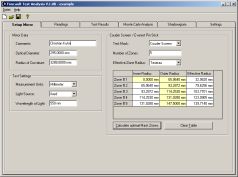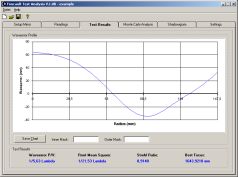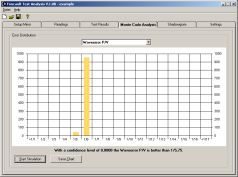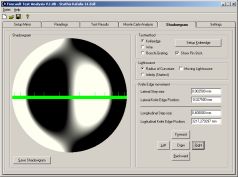
homepage | introduction | version history | download | screenshots |
|
introduction
|
Welcome to Foucault Test Analysis!
Foucault Test Analysis for Windows is a program for the evaluation of the readings taken in the Foucault test and will be offered as freeware. You can download it here.
Foucault Test Analysis calculates the Waveerror P/V, as well as the RMS and Strehl-ratio on the basis of the measured longitudinal abberations. The waveerror-profile-diagram tells you which mirror-zones needs further correction. For getting an impression about the validity of your own measurements the program offers the Monte Carlo analysis.
Additionally the program simulates the shade pictures on basis of your own readings. For viewing the shade pictures you can choose between the classical knife edge, the Ronchi grating or a thin wire (wire test). You also can put the couder mask or pin-stick on the mirror and try to reproduce your own readings.
The mirror data can be loaded, modified and saved at any time. In order to track the state of mirror correction, the readings can be stored in a logfile.
Nearly five month after the first release the program is now BETA. The major change is that the mirror results are calculated according to Jim Burrows now. Furthermore several bugs were removed and program handling was improved. See version history for details.
I have tested my software carefully. But if you find still a bug or if you have suggestions for following versions I would be glad hearing from you. The missing HTML-Help-file will be included in the final version of this program.
Have much fun with the program
Andreas Reifke
andreas.reifke@web.de
|
version history
|
| 29.06.2003 | Bugfix/improvements
for Version 1.0B:
|
| 08.03.2003 | Version
1.0B released. Major changes are:
|
| 20.10.2002 | First version of the program made available as a release candidate (1.0A). Except the missing HTML assistance the program is complete. Please test the program and give feedback ! |
|
download
|
The setup-file is a self-extracting EXE and contains the actual programm as well as all necessary Windows-controls. Since the program needs the runtime-environment for Visual Basic 6.0, I offer the VB-runtime-environment for download as well.
| File name | Date | File size | Description |
| fouc10b.exe | 08.03.2003 | 2.082 KB | Foucault
Test Analysis 1.0B Windows Controls |
| vbrun60sp5.exe | 08.03.2003 | 1.024 KB | Visual
Basic Runtime 6.0 SP5 |
|
screenshots
|
Click on the pictures to enlarge !
Register Mirror Setup
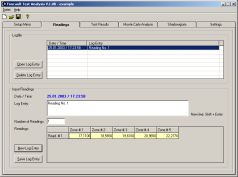 |
Here
you enter your readings determined in the Foucault test.
If you want, you can enter a comment and store your
readings in a logfile. Logfile entries can be changed and deleted at any time. |
Register Test Results
Register Monte Carlo Analysis
Register Shadowgram
Register Settings
| (c) 2002-2003 Andreas Reifke - E-Mail: andreas.reifke@web.de |
